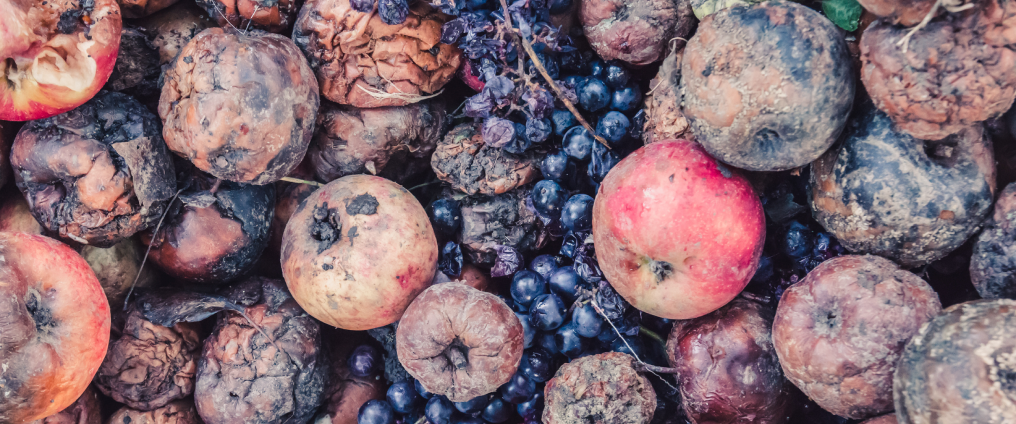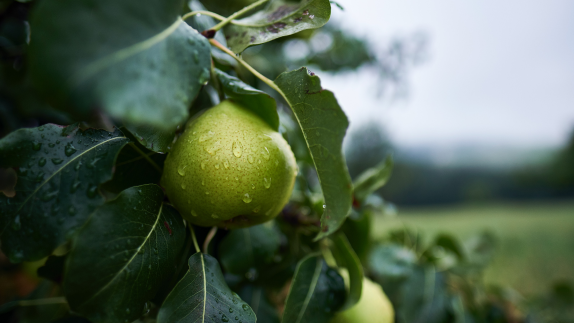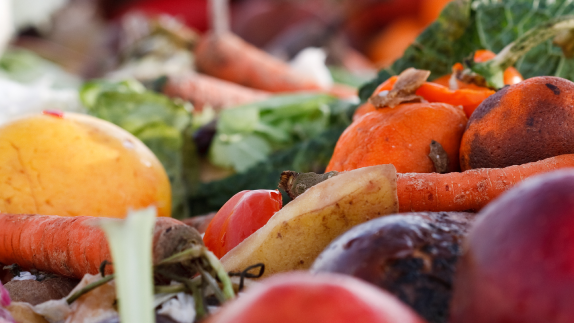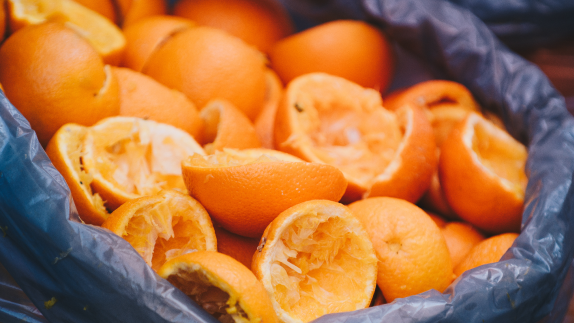We can build a circular food system that ensures our food never creates waste. A circular food system provides economic opportunities, tackles climate change, protects biodiversity, and builds greater long-term resilience.
In a circular economycircular economyA systems solution framework that tackles global challenges like climate change, biodiversity loss, waste, and pollution. It is based on three principles, driven by design: eliminate waste and pollution, circulate products and materials (at their highest value), and regenerate nature.:
food waste is prevented
surplus edible food can be redistributed to people who need it
inedible food by-products and human waste become inputs for new products
Today’s food system is wasteful
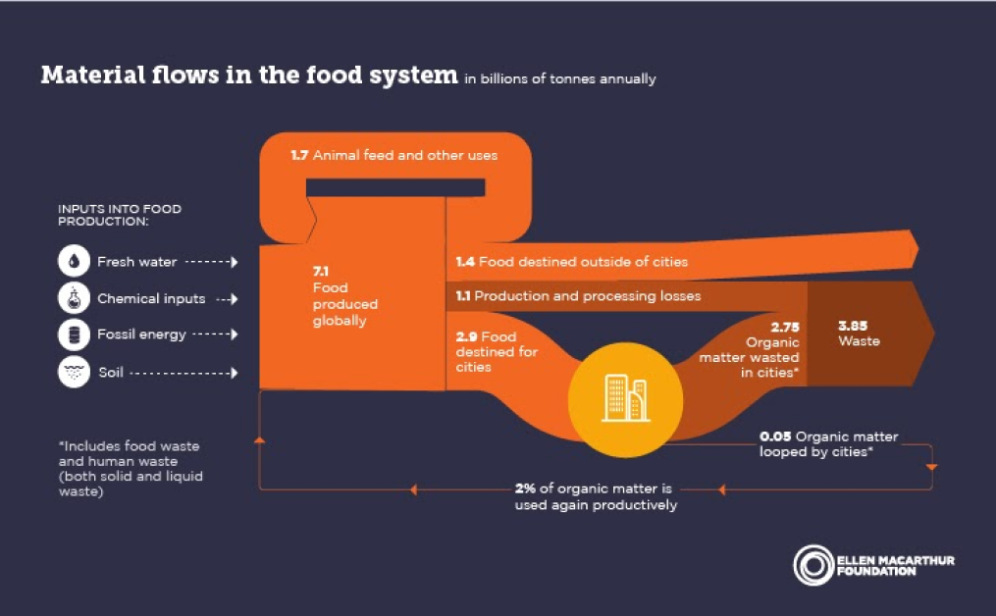
In today’s linear system, massive volumes of freshwater, synthetic inputs like chemical fertilisers, fossil-derived energy, and soil are used to produce 7.1 billion tonnes of food globally. Yet, so much of this is wasted.
A large proportion of our food is destined for consumption within cities, where 2.8 billion tonnes of food waste and human waste are created each year. In cities, less than 2% of organic waste and the nutrients it contains is captured, treated safely, and used productively again. This results in missed economic opportunities and negative impacts on human health, local ecosystems, and agricultural land.
Solutions for waste
Prevent edible food waste and loss
Preventing food waste and loss is better for the environment and makes economic sense. Technological solutions like Winnow can help businesses to identify opportunities to reduce their food waste. Organisations such as Apeel have produced innovative solutions to extend the shelf-life of fresh produce, preventing food waste whilst eliminating the need for plastic packaging.
Redistribute surplus edible food
Surplus edible food should be redistributed for human consumption, helping divert food waste from landfill.
Organisations like Refettorio Gastromotiva use redistributed surplus edible food to provide high-quality nutrition to food-insecure populations.
New business models like Too Good To Go, which allows consumers to purchase close to expiry foods at a discounted price, are facilitated through technology.
Turn food by-products into new things
Even in a scenario where surplus edible food is prevented and redistributed, inedible food by-products and human waste would continue to be produced. This can be made into various products for use in the agri-food sector and beyond.
These include:
Food ingredients
Surplus edible food and the by-products generated during the production, processing and consumption of food (that may not commonly be considered edible) can be used as ingredients for new food products by food brands and providers.
Using these by-products can create new revenue streams and help address nutrition and hunger challenges, whilst providing more food from the same land area, thereby helping to protect natural ecosystems by reducing the pressure to convert them into farmland.
The Upcycled Food Association represents more than 75 member organisations transforming waste into a host of innovative new food products.
Inputs for agriculture
The valuable organic materials in food by-products and human waste today can be safely returned to agricultural land as compost and digestate from anaerobic digestionanaerobic digestionMicrobial breakdown of organic matter in the absence of oxygen.. These inputs help rebuild soil organic matter, improve soil health, increase water infiltration and retention, prevent erosion, and allow the soil to sequester more carbon.
Innovators transforming organic matter into agricultural inputs include Lystek, who use human waste to produce fertilisers and the Nutrient Upcycling Alliance, who use urban organic waste streams to produce fertilisers. Other innovators use organic matter to make animal feed, such as Agriprotein, who use black soldier fly to transform food waste into fish feed for aquaculture.
New materials
The value of organic materials can be captured by transforming them into new biomaterials for use as packaging or in construction, fashion, pharmaceutical and other industries. New products would be designed so that the materials that they are made from can stay in use and, where appropriate, regenerate natural systems. For example, Ecovative transforms agricultural residues into a portfolio of materials with a range of properties that can be used for different applications.
Bioenergy
Energy generation as a by-product of producing other valuable products, e.g. producing biogas in addition to digestate from anaerobic digestion, makes full use of the materials contained in food by-products and is part of a circular economy for food. However, energy generation solely through incineration of organic waste does not meet this standard and is not part of a circular economy.
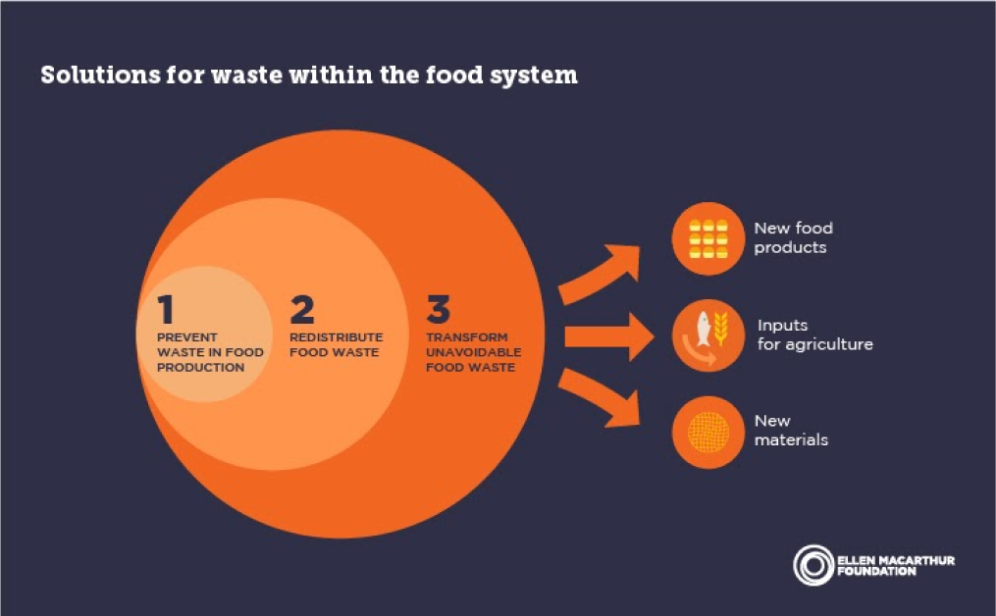
Besides ensuring that edible food is redistributed, there is no strict hierarchy of the remaining different product types described in Figure 2. Whether the unavoidable waste is made into new food products, inputs for agriculture or new materials depends on the local context and demand.
The role of different actors in a new food system
An unprecedented level of collaboration is required to transform the food system. Diverse actors have an essential role in ensuring that waste is eliminated from the future food system.
Food brands and manufacturers
Redesign food products by using ingredients made from food by-products.
Examples: Planeterians, Upcycled Food Association
Retailers
Prevent edible food waste through improved logistics, matching food volumes to demand, redistributing surplus edible food, using ‘ugly’ produce as ingredients.
Example: Spoiler Alert
City or municipality governments
Put in place infrastructure and policies for separate organic waste collection and for wastewater treatment systems that make valuable products from human waste.
Put in place infrastructure to bring fertilisers made from urban organic waste to peri-urban farms (linked to local food sourcing).
Provide incentives through policies and funding programmes for food businesses to take actions based on circular economy principles.
Examples: Italian cities organic waste collection, Lystek Guelph, Connect the Dots
Restaurants
Redesign menus by using ingredients made from food by-products.
Examples: AMASS, Helsinki Restaurants
Resource and waste management companies
Put in place infrastructure to bring fertilisers made from urban organic waste to peri-urban farms (linked to local food sourcing).
Innovate for advanced organic waste collection and treatment systems; and put in place wastewater treatment systems that make valuable products from human waste.
Work with public and private sector players to develop valuable products made from their food by-products. b
Examples: NUA Lystek Guelph, De Clique, Nutrient Upcycling Alliance
Farmers
Reduce on-farm losses by changing practices
Use fertilisers made from organic waste streams
Examples: Agricycle, NUA
